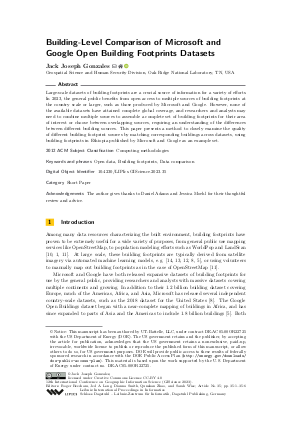Building-Level Comparison of Microsoft and Google Open Building Footprints Datasets (Short Paper)
Author
Jack Joseph Gonzales 
-
Part of:
Volume:
12th International Conference on Geographic Information Science (GIScience 2023)
Part of: Series: Leibniz International Proceedings in Informatics (LIPIcs)
Part of: Conference: International Conference on Geographic Information Science (GIScience) - License:
 Creative Commons Attribution 4.0 International license
Creative Commons Attribution 4.0 International license
- Publication Date: 2023-09-07
File

PDF
LIPIcs.GIScience.2023.35.pdf
- Filesize: 0.87 MB
- 6 pages
Document Identifiers
Subject Classification
ACM Subject Classification
- Computing methodologies
Keywords
- Open data
- Building footprints
- Data comparison
Metrics
- Access Statistics
-
Total Accesses (updated on a weekly basis)
0PDF Downloads0Metadata Views
Abstract
Large-scale datasets of building footprints are a crucial source of information for a variety of efforts. In 2023, the general public benefits from open access to multiple sources of building footprints at the country scale or larger, such as those produced by Microsoft and Google. However, none of the available datasets have attained complete global coverage, and researchers and analysts may need to combine multiple sources to assemble a complete set of building footprints for their area of interest or choose between overlapping sources, requiring an understanding of the differences between different building sources. This paper presents a method to closely examine the quality of different building footprint sources by matching corresponding buildings across datasets, using building footprints in Ethiopia published by Microsoft and Google as an example set.
Cite As Get BibTex
Jack Joseph Gonzales. Building-Level Comparison of Microsoft and Google Open Building Footprints Datasets (Short Paper). In 12th International Conference on Geographic Information Science (GIScience 2023). Leibniz International Proceedings in Informatics (LIPIcs), Volume 277, pp. 35:1-35:6, Schloss Dagstuhl – Leibniz-Zentrum für Informatik (2023)
https://doi.org/10.4230/LIPIcs.GIScience.2023.35
BibTex
@InProceedings{gonzales:LIPIcs.GIScience.2023.35,
author = {Gonzales, Jack Joseph},
title = {{Building-Level Comparison of Microsoft and Google Open Building Footprints Datasets}},
booktitle = {12th International Conference on Geographic Information Science (GIScience 2023)},
pages = {35:1--35:6},
series = {Leibniz International Proceedings in Informatics (LIPIcs)},
ISBN = {978-3-95977-288-4},
ISSN = {1868-8969},
year = {2023},
volume = {277},
editor = {Beecham, Roger and Long, Jed A. and Smith, Dianna and Zhao, Qunshan and Wise, Sarah},
publisher = {Schloss Dagstuhl -- Leibniz-Zentrum f{\"u}r Informatik},
address = {Dagstuhl, Germany},
URL = {https://drops.dagstuhl.de/entities/document/10.4230/LIPIcs.GIScience.2023.35},
URN = {urn:nbn:de:0030-drops-189309},
doi = {10.4230/LIPIcs.GIScience.2023.35},
annote = {Keywords: Open data, Building footprints, Data comparison}
}
Author Details
Acknowledgements
The author gives thanks to Daniel Adams and Jessica Moehl for their thoughtful review and advice.
References
-
Gianluca Boo, Edith Darin, Douglas R Leasure, Claire A Dooley, Heather R Chamberlain, Attila N Lázár, Kevin Tschirhart, Cyrus Sinai, Nicole A Hoff, Trevon Fuller, et al. High-resolution population estimation using household survey data and building footprints. Nature communications, 13(1):1330, 2022.

-
Maria Antonia Brovelli and Giorgio Zamboni. A new method for the assessment of spatial accuracy and completeness of openstreetmap building footprints. ISPRS International Journal of Geo-Information, 7(8):289, 2018.

- Hongchao Fan, Alexander Zipf, Qing Fu, and Pascal Neis. Quality assessment for building footprints data on openstreetmap. International Journal of Geographical Information Science, 28(4):700-719, 2014. URL: https://doi.org/10.1080/13658816.2013.867495.
- Google. Google maps, 2023. URL: https://google.com/maps.
- Google. Google open buildings, 2023. URL: https://sites.research.google/open-buildings/.
-
Robert Hecht, Carola Kunze, and Stefan Hahmann. Measuring completeness of building footprints in openstreetmap over space and time. ISPRS International Journal of Geo-Information, 2(4):1066-1091, 2013.

- Christophe Leys, Christophe Ley, Olivier Klein, Philippe Bernard, and Laurent Licata. Detecting outliers: Do not use standard deviation around the mean, use absolute deviation around the median. Journal of Experimental Social Psychology, 49(4):764-766, 2013. URL: https://doi.org/10.1016/j.jesp.2013.03.013.
- Microsoft. Microsoft global ml footprints, 2023. URL: https://github.com/microsoft/GlobalMLBuildingFootprints.
- Nikola Milojevic-Dupont, Felix Wagner, Florian Nachtigall, Jiawei Hu, Geza Boi Brüser, Marius Zumwald, Filip Biljecki, Niko Heeren, Lynn H. Kaack, Peter-Paul Pichler, and Felix Creutzig. EUBUCCO v0.1: European building stock characteristics in a common and open database for 200+ million individual buildings. Scientific Data, 10(1):147, March 2023. URL: https://doi.org/10.1038/s41597-023-02040-2.
- J. J. Moehl, E. M. Weber, and J. J. McKee. A vector analytical framework for population modeling. The International Archives of the Photogrammetry, Remote Sensing and Spatial Information Sciences, XLVI-4/W2-2021:103-108, 2021. URL: https://doi.org/10.5194/isprs-archives-XLVI-4-W2-2021-103-2021.
- OpenStreetMap contributors. Open Street Map retrieved from https://planet.osm.org . https://www.openstreetmap.org , 2023.
- Wojciech Sirko, Sergii Kashubin, Marvin Ritter, Abigail Annkah, Yasser Salah Eddine Bouchareb, Yann Dauphin, Daniel Keysers, Maxim Neumann, Moustapha Cisse, and John Quinn. Continental-Scale Building Detection from High Resolution Satellite Imagery, July 2021. Number: arXiv:2107.12283 arXiv:2107.12283 [cs]. URL: http://arxiv.org/abs/2107.12283.
- Benjamin Swan, Melanie Laverdiere, H. Lexie Yang, and Amy Rose. Iterative self-organizing SCEne-LEvel sampling (ISOSCELES) for large-scale building extraction. GIScience & Remote Sensing, 59(1):1-16, December 2022. URL: https://doi.org/10.1080/15481603.2021.2006433.
- Hsiuhan Lexie Yang, Jiangye Yuan, Dalton Lunga, Melanie Laverdiere, Amy Rose, and Budhendra Bhaduri. Building Extraction at Scale Using Convolutional Neural Network: Mapping of the United States. IEEE Journal of Selected Topics in Applied Earth Observations and Remote Sensing, 11(8):2600-2614, August 2018. URL: https://doi.org/10.1109/JSTARS.2018.2835377.
-
Qi Zhou, Yuheng Zhang, Ke Chang, and Maria Antonia Brovelli. Assessing osm building completeness for almost 13,000 cities globally. International Journal of Digital Earth, 15(1):2400-2421, 2022.

